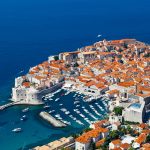As Jasmina Trstenjak/Filip Pavic/Novac writes on the 1st of May, 2019, the Republic of Croatia does have a chance in the car industry, and it can improve its investment portfolio with certain active and proactive measures, open up opportunities for the development of new industries, and not miss this third train, since it has already missed two. Rimac Automobili, the company of one of Croatia’s most successful entrepreneurs, Mate Rimac, is more than ready to help if Croatia truly wants to attract the car industry to Croatia. With some work put in to it, it’s possible.
The above is one of the key messages given by Mate Rimac, the founder and CEO of Rimac Automobili, which was part of the “Croatia E-mobility Forum”, held recently at the Esplanade Hotel in Zagreb and organised by the American Chamber of Commerce (AmCham) and Jutarnji List, during which spoke about “How Croatia can attract the automotive industry”.
In his presentation, among other things, analysed the countries that make up Central and Eastern Europe, what the automotive industry brought to them (growth, jobs, contribution to GDP…), which attracted investors, just how Croatia stands in this aspect. He also noted some key trends that are already transforming the car industry.
The automotive industry is completely changing, therefore the use of cars will eventually alter too. People will, at some point, no longer be car owners, they might not even bother to learn to drive, but all this will open up many new doors. Trends show that many cars will become autonomous by 2030, they will all be connected to the internet, more electrification will occur, and the car sharing will become more common. Mate Rimac discussed these points, full of experience as his own company, which has grown into a powerful technology company over the past decade and attracted more investment than all the technology companies in Croatia.
So far, Rimac Automobili has attracted more than 60 million euros in foreign investment, and that’s not even counting the European Investment Bank (EIB), which has provided the company with a 30 million euro loan last year. The last investor in Rimac Automobili was no less than Porsche, and that was the very first time Porsche invested in another company.
”We don’t want this to be the last investment, but we need to attract investments. Not only because of us, but also because of the state, so that the automotive industry invests in other things in Croatia. This year, a big investor will enter into the structure of our company. It’s a 150 million euro investment, and the details on that will be known in a few weeks,” revealed Rimac. He also emphasised the significance and the power of the branch in which he works – if the automotive industry was a country, it would be the fourth largest in the entire world!
However, rather unsurprisingly, Croatia is lagging behind quite significantly when compared to others, the automotive industry has spread very well across the whole of Europe and Croatia is almost the only exception. Two waves of investment in the region have already been and gone. The first was in the Czech Republic, Poland, Slovenia, the second was in Romania and Slovakia, and now a lot is being invested in neighbouring Serbia.
In the aforementioned countries, the automotive industry started practically from scratch and through the investments of other manufacturers, unassuming little Slovakia has become the largest car maker per capita in the world today. Therefore, in his extensive presentation, Rimac also commented on the way companies choose their sites, what their criteria are, and, when comparing Croatia with other countries, he found that Croatia is not one of the best candidates at all.
”Croatia has thirteen billion dollars worth of exports, with four million people. Slovakia has a million residents and more than 78 billion dollars in exports, out of which, 20 billion dollars of exports are in cars and parts alone. Let’s look at some closer neighbors. Slovenia, with more than two million inhabitants, is exporting more than Croatia, and once again, their main export products are cars, and for us, it’s wood,” said Rimac, adding that these countries attracted companies with their favourable labour costs, but also for their talents and good faculties, infrastructure and available capital.
He also noted that Croatia has less than a billion dollars of automotive revenue, while, let’s say, the Czech Republic has 41 billion dollars, and it has a strong potential. Thus, Croatia has less than half a percent of GDP, and the Czech Republic accounts for more than five percent of its GDP directly from the automotive industry, which is indeed a very defeating comparison. In the CEE region, investments have occurred thanks to generally cheap labour, and although much of it has well and truly bypassed Croatia, Mate Rimac is certain that there is a way to attract this industry still. Not necessarily with cheaper labour, but also with new opportunities.
”Hundreds of e-car models are coming onto the market. They’re developed during a period of four to seven years and what’s going on in the labs today will be on the roads within several years. There is a tremendous opportunity since today’s share of three percent in sales will jump to 60 percent in the coming decades. That’s why there’s a lot of investment going on in the automotive industry, in startups and in technology companies. So far, more than 25 billion dollars has been invested through investment ventures, and this is where that industry is heading. There are investments in the development of batteries, in companies that make sensors and the like. The portfolio is bigger than it used to be. Also, there’s a lot of heavy investment in development, and budgets are larger,” noted Rimac.
Rimac also added that not everything is so black, although Croatia is of course late ”to the party”, and is missing out on the opportunity to join the development of the automotive industry by modelling itself on the countries of the CEE region. That industry, he says, is growing steadily, and countries are committed to receiving investments and attracting firms.
”We don’t want just any investment, but those that give maximum benefit. But it’s not about how much the state will encourage these industries to come. The state must first determine in which direction it wants to go, which industries it has, and then work proactively. England has a great initiative and it does very well because it has a complex program for the automotive industry, it works proactively, runs research centres, test sites… Therefore, proactive measures and projects are needed if there’s a desire to go in that direction,” Rimac said.
The presentation outlined nineteen action measures that the Croatian state should take to accelerate the automotive industry’s progress in Croatia.
He mentioned that employees should be allowed to enter into company ownership and there should be a reduction in income taxes on high salaries.
Universities should make sure their programs include more machine learning, artificial intelligence, and electrical engineering.
Universities should employ professors from the STEM sector with scientific reputations, Rimac believes, and invest in equipping faculties and linking universities with actual investors.
In addition, the state should implement tax incentives for R&D-oriented companies, as well as meet with relevant engineers, as well as take a more proactive role in industrial development in co-operation with potential foreign investors.
As far as infrastructure is concerned, it’s very important to encourage international contacts with cities that have developed automotive and innovation hubs and additionally invest in the 5G network for all households.
When it comes to specific measures for the automotive industry, among the measures listed above, it’s necessary for foreign automotive employees to have temporary housing and job search support provided to the employee’s life partner.
Additionally, one of the measures implies the establishment of an international school, where teaching will be conducted in foreign languages.
As far as the infrastructure of the auto industry itself is concerned, Rimac says that the testing of autonomous vehicles on public roads should be legalised, there should be an institute for electric and autonomous vehicles established, as well as an institute for artificial intelligence, as well as centres of competence and innovation hubs.
Make sure to follow our dedicated business page for much more.
Click here for the original article by Jasmina Trstenjak/Filip Pavic for Novac/Jutarnji








